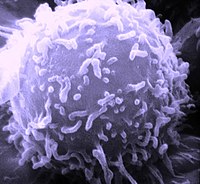
Photo from wikipedia
Background: Radiotherapy (RT) is a highly effective anti-cancer treatment forming the standard strategies for brain metastasis in non-small cell lung cancer (NSCLC) patients, but local and distal disease recurrence remains… Click to show full abstract
Background: Radiotherapy (RT) is a highly effective anti-cancer treatment forming the standard strategies for brain metastasis in non-small cell lung cancer (NSCLC) patients, but local and distal disease recurrence remains a major cause of mortality. RT is known to enhance tumor immunogenicity and T cell receptor (TCR) repertoire diversity. however, the genomic evolution and mechanisms of RT induced immune responses are unknown. Method: Here, we perform targeted deep sequencing of circulating tumor DNA (ctDNA) on peripheral blood samples and cerebrospinal fluid (CSF) samples collected prior to and during brain radiotherapy from 13 NSCLC patients with brain metastasis. We used a panel to identify cancer-associated gene mutations and analyze tumor mutation burden. We applied next-generation sequencing (NGS) to investigate the T-cell receptor (TCR) repertoire. Results: In this study, we showed that patients with high blood TMB (high >10 mutations/Mb) tended to benefit from brain radiotherapy both in the terms of clinical outcomes of brain lesions and lung lesions. High TMB of CSF was correlated with a favorable clinical efficacy of brain. Response to therapy indicated according to the changes of ctDNA level between baseline and 28 days post-treatment was consistent with clinical outcomes of lung lesions measured by thoracic CT. Moreover, we showed that the low overlap of TCR repertoire in paired blood samples (base to T0) was detected in patients with partial relief (PR), and high overlap of TCR repertoire was in patients with disease stable (SD). Within 24h post-therapy, a high degree of TCR overlap in peripheral blood and CSF was observed from patients with PR in lung lesions, and a low degree of TCR overlap was from patients with SD in lung lesions. Conclusion: These data demonstrated the potential of ctDNA analysis to be a sensitive tool for predicting treatment responsivity, and the level of TCR repertoire overlap correlated with clinical outcomes.
Journal Title: Journal of Thoracic Oncology
Year Published: 2018
Link to full text (if available)
Share on Social Media: Sign Up to like & get
recommendations!